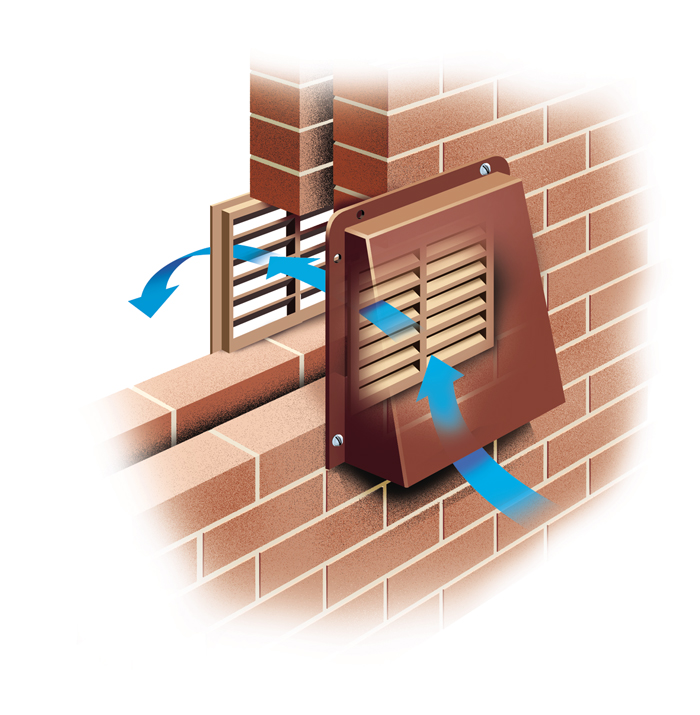No Results Found
The page you requested could not be found. Try refining your search, or use the navigation above to locate the post.
Dri-Cowl external nine inch air brick cover
Prevents the full force of wind and/or rain directly penetrating into the dwelling, which can cause extensive damage to plasterwork and decoration, and discomfort for the tenant. The Dri-Cowl when fitted will still allow adequate ventilation to flow freely. The strengthening bottom bar also prevents “runup”.
The fitting of Dri-Cowl does away with the tenants overall psychological need to internally block off the air brick, which negates its function and could cause hazardous air pollution and fumes.
Dri-Cowl is also invaluable when used as a cover for extractor fans, as in windowless bathrooms, extras to kitchens etc., eliminating draughts and irksome “Blade” noise and allowing the fan to fully function even against strong prevailing winds. Dri-Cowl is manufactured from high quality aluminium and finished in brown and comes complete with fixings. The Dri-Cowl is easily fixed on site using screws and silicone/polysulphide mastics.
Click the dri-cowl image to buy, or if you have any questions see the FAQs bel0w, or call us.
FAQ’s
Can I cover up an air brick?
Covering up an air brick is generally not recommended as it serves an important purpose of providing ventilation to the space beneath the floor. By providing ventilation you can help prevent the buildup of moisture, which could well lead to issues with damp, mould growth, and possibly structural damage over time. However, if you are worried about drafts or energy efficiency, it may be worth considering installing vented air brick covers. If you are still unsure it is advisable to get professional advice on alternative solutions that maintain adequate airflow while addressing your specific needs.
Can rain get in through air bricks?
In short yes, rain has the potential to get through air bricks, especially during heavy downpours or strong winds. The purpose of air bricks is to allow airflow for ventilation, but their open design also makes them susceptible to the ingress of water. How much rain gets through air bricks is dependent on a number of factors such as the size and placement of the bricks, the intensity and direction of the rainfall, and the presence of any protective covers or screens.
If you want to prevent water damage, our advice would be to consider installing air brick covers. Air brick covers will significantly minimise the amount of rain or wind entering your property while still allowing you the ventilation needed to keep your home free from damp.
How do you cover air bricks with mesh?
When covering air bricks with mesh the first thing you need to do is measure the dimensions and obtain mesh screens or grilles that fit snugly over them. Then make sure you clean the surface around the air bricks before applying a weatherproof sealant or adhesive around the edges of the mesh screen. You can then carefully press the mesh into place, ensuring it’s level and securely adhered. As an additional measure you can use screws or clips to further secure the mesh if you feel it is necessary. Make sure you pick a mesh material that allows for proper ventilation while preventing pests, debris, and rain from entering through the air bricks. The most commonly used types of mesh are generally those made of galvanised steel or plastic.
Is it OK to cover air vents?
Covering air vents is generally not recommended as it can disrupt proper ventilation and airflow within a building or space. Air vents are designed to allow the circulation of fresh air and removal of stale or contaminated air, which is crucial for maintaining healthy indoor air quality.
If you cover an air vents it can lead to moisture build up, mould growth, and poor air circulation. This can potentially cause other problems for both the property and anyone living or working there. However, occasionally it may be necessary to cover air vents on a temporary basis such as during extreme weather conditions or for privacy reasons. In such cases, it’s advisable to seek professional guidance to ensure your property continuous to receive proper ventilation.
Can mice get through plastic air bricks?
Mice can potentially get through plastic air bricks, especially if there are gaps or cracks in the bricks or surrounding areas. Because they are small and agile mice can squeeze through surprisingly small openings. To stop mice getting through air bricks, the best thing to do is install fine mesh covers or grilles that have openings smaller than 1/4 inch. Regular inspection and maintenance of air bricks and ventilation systems can also help deter mice and other pests


